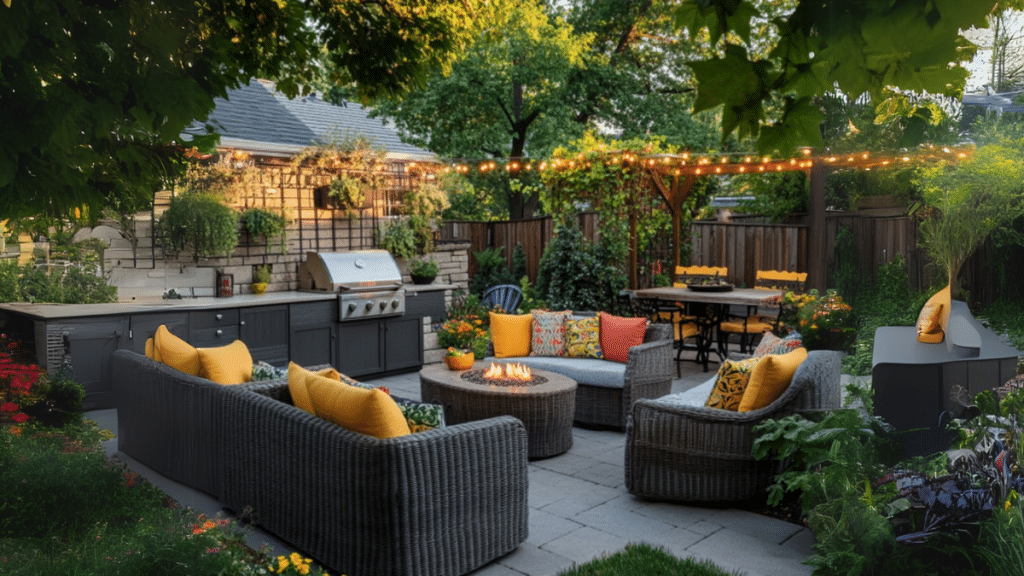If you’re anything like me a year ago, you’re probably staring at your backyard right now, seeing nothing but wasted potential. After spending months researching and working with local residential interlocking contractors and outdoor design experts, I’ve discovered that transforming outdoor spaces isn’t just about laying stones – it’s about creating an extension of your home that actually makes sense for your life.
Let’s skip the filtered Instagram perfection and talk about what really works in outdoor spaces. You know those gorgeous magazine spreads with pristine white furniture and delicate wine glasses? Yeah, that’s not real life. Real life needs spaces that can handle spilled drinks, dropped burgers, and kids running around with sticky popsicle fingers.
The Magic of Zones
Remember how your first apartment probably had your bed, dining table, and desk all crammed into one room? Your outdoor space doesn’t have to feel like that. By using different paver patterns and layouts, you can create distinct areas that flow naturally. Maybe a cozy corner for your morning coffee, a solid cooking station that doesn’t wobble every time you flip a burger, and a lounge area where people actually want to hang out.
Small Space? No Problem
Living in a shoebox-sized yard doesn’t mean you can’t have an amazing outdoor space. It’s about being smart with what you’ve got. Think built-in bench seating that doubles as storage, or a slim bar-height table against the wall for when you want to work outside. The trick is maximizing every inch without making it feel cramped.
The Reality of Maintenance
Can we talk about upkeep for a minute? Because nobody wants to spend their weekends scrubbing their patio. The beauty of modern pavers is that they’re basically the lazy person’s dream. A quick sweep, occasional rinse, and you’re done. No endless sealing, no pressure washing marathons, no trying to kill weeds growing through cracks.
Making It Actually Functional
Here’s what matters: creating spaces that work for your real life. Maybe you need a stable surface for your kids’ art projects that won’t stain. Or perhaps you’re tired of dragging chairs in and out every time friends come over. Think about what drives you nuts about your current setup – that’s where you start.
Weather-Proof Your Investment
Let’s face it – weather is weird now. One day it’s burning hot, the next you’re breaking out sweaters. Good pavers can handle these mood swings way better than traditional surfaces. Plus, when something does go wrong (thanks, last winter), you can replace individual pieces instead of redoing the whole thing.
The Social Factor
There’s something about a well-designed outdoor space that makes people want to linger. It’s not just about having seating – it’s about creating spots where conversations naturally flow. Think circular layouts instead of straight lines, varying heights for different groups to cluster, and ensuring no one feels stuck in the hot sun.
Starting Without Freaking Out
Listen, I get it. Staring at your sad backyard and imagining something better is intimidating. Start by thinking about how you actually use your space now and how you wish you could use it. Be honest with yourself. If you’ve never grilled before, maybe don’t build an entire outdoor kitchen. Start small, but plan smart.
And please, for the love of your wallet, check local codes before you start. Nothing kills the joy of a new patio faster than finding out you need to tear it up because of permit issues.
Making It Your Own
Your outdoor space should make your life better, not just prettier. Whether you’re dreaming of epic backyard parties or just want a peaceful spot to drink your coffee, focus on what matters to you. Because at the end of the day, the best outdoor space is one that feels like it was made just for you – because it was.
Remember, this isn’t about keeping up with the Joneses or recreating some perfect Pinterest board. It’s about making your outdoor space work for your actual life, messy bits and all. And trust me, once you get it right, you’ll wonder why you ever settled for that sad concrete slab in the first place.
